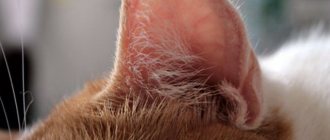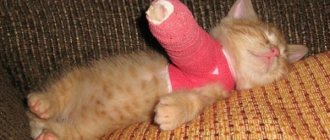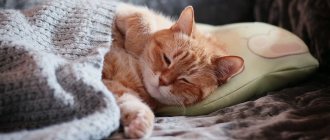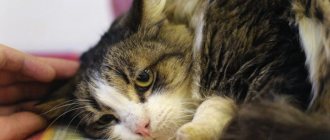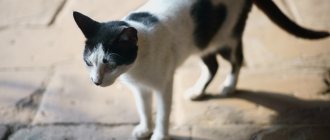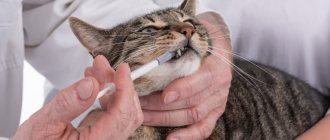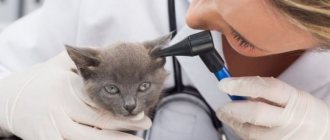Causes of stomatitis
Depending on the causes, all stomatitis is divided into primary and secondary. The first category develops on its own and has its own specific causes of occurrence. The second category of stomatitis occurs as a concomitant symptom of some other underlying disease of a viral, fungal or bacterial nature.
Causes of primary stomatitis
- any mechanical injuries (scratches, punctures, wounds) due to something foreign getting into the mouth or due to an incorrect bite;
- chemical and thermal effects (the influence of ice water or excessively hot food, irritating chemicals entering the mouth, chewing poisonous-irritating plants, etc.);
Causes of secondary inflammation
- fungal, viral or bacterial infections (for example, panleukopenia - feline distemper, candidiasis, leukemia, etc.);
- food allergic reactions;
- pathologies of the liver, kidneys and gastrointestinal tract (gastroenteritis, uremic syndrome, hepatitis, etc.);
- endocrine pathologies in metabolism (diabetes mellitus);
- diseases of the masticatory apparatus (tartar, caries, autoimmune reactions).
Types of inflammation of the oral cavity, how they manifest themselves
According to their course, inflammation of the oral cavity can be acute or chronic. Acute stomatitis has a clear clinical manifestation and develops quickly. Chronic stomatitis has a sluggish clinical course and can provoke general malaise in the cat.
According to their distribution in the mouth, they are divided into focal and diffuse - focal do not cover the entire mouth, diffuse most often affect the entire mucous membrane of the oral cavity, including the gums, the inner surface of the cheeks, lips and palate. According to the course and manifestation of stomatitis in cats, the symptoms are very diverse:
CatarrhCatarrhal stomatitis occurs most often - the beginning of all complicated stomatitis in the case of improper or neglected treatment. Classic signs of inflammation are intense redness, swelling, sore gums, increased salivation, and unpleasant odor from the mouth. Plaque may appear on the gums and inner surface of the cheeks. Often develops against the background of diseased teeth or tartar. The saliva is viscous and smells unpleasant. |
Papillomatous stomatitisThis is the result of the life activity of the papilloma virus in the cat’s body, i.e. full-fledged viral stomatitis. In the area of the cheeks and lips, cauliflower-shaped growths form on the mucous membrane. With normal functioning of the immune system, after 7-12 weeks everything goes away on its own as suddenly as it appeared. If this does not happen, surgical removal of papillomas will be accompanied by appropriate antiviral and immunostimulating therapy. |
Diphtheritic formIt is very rare in cats and is manifested by the formation of a white coating, which is difficult to remove, and underneath there are areas of even greater inflammation or even bleeding ulcers. |
Phlegmonous stomatitisIt is characterized by an accumulation of pus under the first thin layer of mucous membrane, which changes color from bright pink to gray and bluish. When the places of such accumulations are punctured, pus is released. The risks of sepsis (blood poisoning) are very high; oral cleaning is often carried out under general anesthesia. |
Gangrenous stomatitisIn most cases, it is a complication of ulcerative or phlegmonous. The mucous membrane simply begins to die. A sharp, foul odor emanates from the mouth. Surgical stripping of the affected tissue is clearly indicated. There are high risks of developing sepsis and death of the pet. Often accompanied by fever and enlarged submandibular lymph nodes. |
Ulcerative formUlcerative - weeping ulcers are found over the entire surface or in places, the size and depth of which depends on the cause of occurrence and the duration of the disease. Body temperature may rise. If during the treatment the healing of ulcers does not occur correctly, then this form develops into ulcerative stomatitis with granulations (overgrowth with pathological connective tissue) and, further, into necrosis (complete death of the mucous membrane with complete disruption of its functions). |
A special form of stomatitis, in which inflammation develops against the background of the body’s rejection of its own teeth. Very clear signs of inflammation are observed right around the dental arcades, and near all of them. The course is greatly complicated when infectious agents are attached. Conventional treatment according to the classical scheme does not produce absolutely any results. Tooth extraction cannot be avoided. |
Uremic syndromeThe most severe complication of chronic renal failure. Usually precedes the death of the animal. This form of stomatitis can only be determined using laboratory blood tests. It occurs due to toxic substances that accumulate in the blood of a sick animal, causing irritation and inflammation from the inside. |
Description of the disease
The disease is caused by the Feline calicivirus (FCV). It affects the upper respiratory tract and oral mucosa. Feline calcivirus is registered all over the world, including in Russia. It affects domestic and wild representatives of the cat family. There is no breed selectivity for this infection. Calcivirus is one of the most common causes of upper respiratory tract diseases in cats (along with the herpes virus). Kittens over 2 months old and young kittens up to 2 years old are susceptible. They make up about 90% of the total number of sick animals.
On a note! If the cat is vaccinated against calcivirus infection, then suckling kittens will be protected from infection during the period of feeding with cat milk.
Calcivirus has many variants (more than 40 strains are known). During reproduction, the pathogen exhibits high variability. In this respect, it is similar to the human influenza virus. Strains of the virus differ in symptoms and severity of the disease. Calcivirosis is considered a mild infection. It is dangerous for small kittens, animals with weakened immune systems, old cats or those with chronic diseases. Cats become infected with calcivirus infection throughout the year. The peak incidence occurs in the autumn-winter period.
Symptoms of stomatitis
5 main signs of stomatitis that should alert the owner and prompt them to examine the cat’s mouth:
- excessive production of saliva, literally dripping from the mouth when the cat is at rest;
- the cat often washes itself, carefully rubbing the mouth area, as if something is bothering it there;
- frequent drinking (drinks almost constantly);
- weak appetite or refusal even of your favorite treats;
- disheveled, unpleasant-smelling fur (the cat, in the process of licking, stains the fur with “bad” saliva).
In addition to the above symptoms, there may also be:
- jumps in body temperature;
- lethargy, inactivity, drowsiness;
- enlarged lymph nodes under the lower jaw;
- unpleasant odor from the mouth;
- complete loss of interest in food;
- pinkish saliva (with impurities of ichor or blood);
- visible swelling and swelling of the lips;
- ulcers, pus, neoplasms, tooth loss.
Symptoms of calcivirosis
Adult cats often become subclinically or asymptomatically ill. An acute course of calcivirosis is noted in kittens. The incubation period lasts from 2 to 17 days. Usually the first symptoms appear 3–5 days after infection. Characteristic:
- bouts of sneezing for 1 – 2 days;
- inflammation of the mucous membrane of the eyes;
- lacrimation;
- runny nose.
On days 3–5 of illness the following are noted:
- increase in body temperature by 1 - 1.5 ° C, in kittens up to 40 - 41 ° C;
- loss of appetite;
- weakness;
- Thick mucus or exudate with pus is released from the eyes and nose;
- the nose is stuffy, the cat breathes through its mouth.
Distemper in cats
Rhinotracheitis
Panophthalmitis
Further symptoms characteristic of calcivirus infection develop.
- Stomatitis and gum inflammation. Red spots appear in the oral cavity on the palate, tongue, and later ulcers form there. They can be on the nose and in the nasal cavity. The cat eats and drinks poorly, makes pushing movements with its tongue, as if it was choking, scratches its nose, coughs, and sneezes. The gums are inflamed, red, swollen, and sometimes a whitish coating is visible on them. There is an unpleasant odor coming from the mouth.
- Profuse drooling.
Body temperature returns to normal after 3–4 days. In kittens and older animals, the infection can develop into viral pneumonia and shortness of breath develops. Inflammation spreads to the trachea, bronchi, and larynx.
Sometimes atypical symptoms appear:
- skin ulcers;
- inflammation of the joints (acute arthritis) - lameness, pain that goes away after a few days;
- ulcers in the stomach and intestines (very rare).
The disease lasts on average 7–10 days , but can last up to 14–21 days . The animal recovers, but continues to release the virus into the external environment. It infects other cats and may have periodic outbreaks of infection. Carrier cats infect their offspring.
Important! After a few months, the intensity of virus release into the external environment decreases. After three months, approximately half of the cats are no longer a source of infection. But some animals remain carriers of the virus for life.
In severe cases, the cat dies from the infection. This mainly occurs due to various complications, the most likely of which are pneumonia and bacterial infection. Death occurs a few days after the onset of the disease. Before death, kittens develop diarrhea, vomiting, and severe weakness. Calcivirosis can become chronic. This is facilitated by the lack of proper treatment and low immunity. The chronic form of calcivirosis manifests itself as stomatitis and gum inflammation. With this form of the disease, the cat requires a course of treatment with immunomodulators every three months. In isolated cases, the disease occurs as a severe systemic infection. It is caused by highly pathogenic strains of calcivirus - vsFCV. The pathogen enters the animal’s body in the usual way, but is not limited to the respiratory tract. The virus infects the inner layer of blood vessels, liver cells, and pancreas. Severe damage to internal organs develops:
- hepatitis;
- pancreatitis;
- nose and intestinal bleeding.
With this form of the disease, swelling of the paws and head, the appearance of ulcers on the animal’s skin, and jaundice are possible. With a systemic infection, more than 60% of sick cats die.
How to examine a cat's oral cavity?
The entire procedure should be carried out slowly, talking affectionately to the pet. The examination usually begins with the gums and teeth, for which the lips are simply raised and lowered.
To look exactly into the mouth, you need to take the cat by the head with one hand along with the upper jaw, so that the thumb and middle finger are at the corners where the jaws meet. Lightly press down on the toothless edge along with the cheek so that it seems to slightly fall into the mouth on the sides. The cat will reflexively open its mouth. Then, with the thumb of your second hand, lightly press the incisors of the lower jaw, holding the chin. The mouth will be open and you can examine it carefully.
Prevention
Cleaning the oral cavity.
It is necessary to accustom the animal to this procedure from a very early age. You should use only special toothpastes that are sold in pet stores. You can also buy a toothbrush there. Regular inspection. Inspect your pet's mouth as often as possible. At the first sign of plaque and tooth decay, contact your veterinarian.
Feeding with specialized food. Protect your pet from eating too hard and spicy food. Feed food at a comfortable temperature.
Timely vaccination. In addition to vaccination, you need to protect your pet from contact with sick animals and under no circumstances feed him from someone else’s bowl.
Quarantine. If you have several animals, and one of them gets sick, then it needs to be isolated. After any contact with an infected animal, you must wash your hands with soap - stomatitis is very contagious!
Help at home before visiting the veterinarian
A visit to the veterinarian is required! Only a specialist will be able to determine what the exact cause of the inflammation was. Without its definition, treatment of stomatitis in cats at home will be pointless, the whole process will become chronic, and this already threatens a deterioration in the general state of health. Moreover, sometimes there may be such pain during examination that treatment manipulations are possible only after introducing it under general anesthesia, and this can only be done in a veterinary clinic.
You can try to help yourself at home only with the initial forms of stomatitis. Self-treatment of extensive ulcerative stomatitis is a reckless decision that can lead to the death of the cat.
What can you do before visiting a veterinarian?
- Remove traumatic objects from the mouth, if any - thorns, bones, blades of grass, etc. If you cannot remove anything from the soft tissues, it makes sense to immediately go to the veterinarian.
- Rinse the mouth using a small rubber bulb, a disposable syringe without a needle with a rubber piston (dispenses liquid smoothly) or a spray bottle (you can take a washed bottle from any old medicine that gave a fine spray): 3% hydrogen peroxide (it is important not to overdo it, so as not to provoke vomiting if accidentally swallowed);
- strong herbal infusions, such as: oak bark, sage, chamomile, string (200-250 ml of boiling water is poured into a container where 1 tsp of one name or mixture of herbs is poured; everything is infused closed for up to half an hour; diluted with boiled water up to 500 ml and brought to room temperature);
- a slightly pink solution of manganese (1:10000) or furatsilin 1:5000 (0.1 g per 0.5 l of boiled water);
- warm 1% soda solution (1 tsp/l of warm boiled water);
- alcohol tincture of calendula, diluted with boiled water in a ratio of 1:10 (1 part tincture, 10 parts water);
- an aqueous solution of methylene blue for treating single ulcers (sold at any pharmacy).
When rinsing, the stream of liquid should be directed to the surface of the gums, slightly tilting the cat's head forward. All liquid products will spread throughout the oral cavity; there is no need to pour anything directly into the mouth (with the exception of the tongue)! It is advisable to do such rinsing after each meal or at least twice a day.
There is no need to do anything additional if tartar, extensive ulcerative or gangrenous stomatitis are detected. Only a specialist can remove tartar, and in case of deep stomatitis, local exposure alone is not enough; antibiotic therapy or even surgical intervention will be required. In such cases, the owner can only help by delivering the pet to the veterinary hospital as soon as possible.
You should definitely put your cat on a special diet of soft, liquid, slimy and jelly foods. Strictly monitor the temperature of the food - it should not be too cold or too hot. For drinking, it is best to use water at room temperature. At first, only acidophilus is recommended from dairy products. If the ulcers are extensive and deep, after washing the mouth and until the visit to the veterinarian, you can go on a fasting diet with free access to water (up to 24 hours).
Description of the disease
Attention!
With stomatitis in cats, the gums, cheeks, palate and even tongue become inflamed.
The causes may be:
- poor oral hygiene and caries formation;
- mucosal injury;
- food that is too hot or cold;
- contact with the mucous membranes of chemicals and certain medications.
Veterinary assistance from a specialist
The diagnosis is made not only on the basis of clinical signs and asking the owner about the pet’s condition and lifestyle over the past few days. Laboratory tests of blood, sometimes urine, and necessarily tests for viral infections are also taken into account. The disease is complex, the clinic is diverse, the correct diagnosis is very important!
In case of a purulent process, before starting treatment with antibiotics, it is advisable to culture the discharge from the mouth in order to accurately determine the susceptibility of the pathogen to a particular antibacterial agent. For gangrenous stomatitis, several different types of antibiotics are often used.
Help is provided through medication, surgery or a combination. What type of therapy is needed is decided individually.
- Surgical assistance consists of prompt removal of the affected mucosa, which has undergone such changes that it is no longer possible to restore it. Moreover, such severely affected areas will interfere with the healing process of relatively healthy tissue. This also includes tooth extraction for autoimmune stomatitis - one of the prerequisites for successful treatment. Important: when removing teeth, do not remove more than two units at a time and be sure to put sutures on the gum flaps to bring the edges of the socket together - this way healing will occur many times faster.
- Combination therapy consists of surgical cleaning of the oral cavity, tooth extraction and further drug treatment.
- The standard course of medical care includes the following points: cleansing the oral cavity of pus and traces of tissue decay;
- suppression of infections during secondary inflammation (antibiotics for stomatitis are prescribed in most cases);
- healing of ulcerated mucosa (after signs of inflammation have disappeared);
- increasing the overall immunity of the animal.
Causes of calcivirosis in cats
Infection occurs in several ways, but the exact route has not been fully established. Scientists can only talk about the factors of microorganism reproduction in the mucous membranes of the oral cavity, conjunctiva, and tissues of the respiratory system.
Infected animals transmit the infection into the environment through secretions from the nose, eyes, or mouth. When you sneeze, the bacteria spreads through the air many meters around. The virus can easily be brought into the house on outer clothing, shoe soles, or dirty hands. Often, infection can be caused by communication between a pet and a selected street cat, which has become a carrier of a dangerous pathogen.
The main methods of transmission of calcivirus include:
- direct contact with an infected cat;
- airborne droplets;
- through cat household items: bowl, tray, toys.
Most often, penetration occurs through inhalation through the mouth or nose; less often, the pathogen is transmitted through the excrement of the carrier. Unfortunately, often the owner does not know whether the pet has a pathogenic microorganism. In this regard, the risk of spreading the infection increases when he visits public places, walks in public with other cats, or during mating. When an infected animal lives in the same place with other baleen animals, the use of one bowl for all animals is sufficient for infection.
The pathogen does not persist outside the body of the individual for a very long period of time. Thus, the maximum survival period is about 18 days. This must be taken into account when choosing a new cat to replace one that died from the disease.
Antiseptics and disinfectant solutions for the oral cavity
- Lugol's solution with glycerin or Lugol's spray for stomatitis (glycerin is included) show excellent disinfecting properties: to treat ulcers directly - smear or spray. You can replace it with an iodine glycerin mixture (1 part iodine + 4 parts glycerin). Important: long-term use is avoided, because can provoke the proliferation of Pseudomonas aeruginosa, which is not affected by iodine;
- Chrorgexidine 0.05% - for washing the mouth or treating wounds and ulcers directly;
- Rotocan is rarely used for mouth treatment in cats, because... in most cases it provokes already excessive salivation;
- Dentavedin gel is used up to 2-3 times a day, applied in a thin layer to sore gums, or placed directly into the sockets after tooth extraction;
- Metrogil-denta in the form of a gel is applied in a very thin layer to areas of inflammation or ulceration. It is important not to overdose, so as not to provoke increased side effects - vomiting, thirst, indigestion, loss of appetite;
- 1-5% solution of Protargol - irrigate the oral cavity in case of inflammation or cauterize ulcers, wounds or sites to remove papillomas with the same type of stomatitis.
Odontoclastic resorptive lesions of teeth in cats (FORLs)
Odontoclastic resorptive lesion is not carious destruction. Defects are often replaced by hyperplastic gums, dental deposits (tartar, soft plaque), and pulp tissue.
There are types 1 and 2:
- Type 1 – destruction that does not lead to the replacement of destroyed roots with bone tissue. The radiography clearly shows the roots and periodontal ligament.
- Type 2 – destruction, leading to the replacement of destroyed roots with bone tissue. On radiography there are no clear boundaries of the root or it may not exist at all; the periodontal ligament is not visualized.
Pathology such as resorption is common in cats. The reason why this disease occurs is not known; there are many theories, but none of them have been proven.
The first stage of damage is a cement defect, odontoclasts destroy enamel and dentin, and a resorptive cavity is formed. The pulp chamber is exposed, high sensitivity and pain appear, the crown often breaks, and the roots remain in the alveolus. Bleeding gums appear, because... sharp edges of the enamel constantly injure the mucous membrane. The formation of mineralized plaque on the surface is common.
Clinically, interest in food is manifested, but it is painful to take food, bleeding gums in the area of the affected teeth, a lack of integrity of the crown can often be observed, the affected part of the crown is replaced by gums or dental deposits.
To make a diagnosis, an examination of the oral cavity by a specialist and radiography is sufficient.
Resorptive teeth are a source of infection, so the only adequate treatment is complete extraction, i.e. removal and careful curettage of the hole.
Often the disease progresses and parallel teeth are susceptible to destruction.
How does a veterinarian treat stomatitis?
Antibiotics, antimicrobials, antivirals and antifungals
- Lincomycin 10% - a course of 3 to 7 days at a dose of 2 ml/10 kg for intramuscular administration and 1 ml/10 kg for intravenous administration;
- Amoxicillin 15% - single injection in a dose of 1 ml/10 kg (or 15 mg/kg) under the skin or into the muscle; if necessary, you can re-inject after 48 hours;
- Oxytetracycline – 0.1 ml/kg body weight once a day for a course of up to 5 days (minimum 3);
- Nystatin and Oxolinic ointments, Levorin, Cholisal and Kamistad gels are applied topically to areas of inflammation and ulceration in a very thin layer, avoiding overdose; have: antifungal, antiviral, anti-inflammatory, wound healing and analgesic effects.
Wound healing
- Actovegin-gel - apply a thin layer to wounds and ulcers in the mouth 2-3 times a day after signs of inflammation have disappeared;
- rosehip oil - smear directly onto the ulcers for faster healing;
- Levomekol (Methyluracil) - apply a thin layer to ulcers and wounds up to 3 times a day, you don’t have to worry about getting into the gastrointestinal tract.
Immunostimulating agents
- Gamavit - 0.3-0.5 ml/kg once a day up to 3 times every 7 days for 2-4 weeks.
- Catozal – 0.5-2.5 ml/animal, depending on the size and severity of the condition, once, repeated after 3-5 days (as necessary);
- Hemobalance – 2-3 times/week. at a dose of 0.25 ml/animal if the weight is up to 5 kg and 0.5 ml/animal if the weight exceeds 5 kg.
Adjuvant therapy for autoimmune stomatitis
- Cyclosporine - 7 mg/kg once daily for 4-16 weeks, depending on the severity of the cat's condition. If disorders in the gastrointestinal tract appear, then the initial dose is ½ of the main daily dose, increasing to the daily dose in 2-3 days;
- Prednisolone is used to suppress inflammation or for targeted immunosuppression. In the first case, the dose will be 0.5 mg/kg twice a day at the beginning of therapy, and after a few days the maintenance dose will be up to 1 mg/kg every other day. In the second case, the main dosage is 1-3 mg/kg twice a day, maintenance - up to 2 mg/kg also every other day.
Treatment of the disease
How to treat calcivirus in cats? Therapy must begin with a correct diagnosis. Without this, treatment cannot be started, because each infection has its own pathogen, which requires specific treatment. So, for calcivirus, it is necessary to prescribe a special hyperimmune serum that contains antibodies to the pathogenic microorganism.
However, if the disease is uncertain, a multicomponent serum should be immediately administered against three viral ailments: panleukopenia, calicivirus, and rhinotracheitis.
If the pet does not eat for a long time or has vomiting, frequent loose stools, or an elevated body temperature, then it is important to place IVs and inject subcutaneous saline solutions of sodium chloride, glucose, and Ringer-Locke. They are used 20-50 ml every 6-12 hours. It should be taken into account that no more than 20 ml of saline solution can be injected under the skin into one place.
It is good to alternate injections and droppers with each other when treating calcivirosis in cats. In the morning you can use sodium chloride, and in the afternoon you can introduce a glucose solution, then again a saline solution, and then glucose. A glucose solution removes intoxication well, promotes the removal of toxins, and a sodium chloride solution helps restore the water-salt balance that occurs due to dehydration. Such alternations help avoid further death of body cells.
After the cat’s body has become sufficiently strong as a result of drug therapy, a therapeutic diet is necessary. Probiotics, that is, drugs that restore intestinal microflora, are introduced into the menu as prescribed by a veterinarian.
Medicines to treat an infected person:
- antibiotics that prevent the development of inflammation and pneumonia;
- vitamin and mineral complexes that strengthen and restore the strength of the convalescent;
- means that speed up metabolism and completely remove intoxication from the body;
- symptomatic treatment that supports the cardiac, respiratory, and digestive systems in a healthy state.
Mostly, medications are administered by injection, since the animal’s oral cavity is very sensitive due to ulcers. Tablets and liquid preparations will only increase the pain of the furry sufferer. Therefore, you will have to learn how to give injections yourself or invite a visiting nurse.
Features of treating a pregnant cat
Unfortunately, doctors are rarely able to save the offspring of a sick female. This is due to the fact that the body devotes all its strength to protecting the mother cat, and the fetus is practically defenseless. A specialist selects the appropriate treatment based on many factors: gestational age, number of fetuses, severity of the disease, etc. The owner’s task is to show the pet to the doctor on time and devote enough time to its treatment.
Features of kitten treatment
It is necessary to start therapy on the very first day the first symptoms appear, otherwise the chances of recovery are greatly reduced. The doctor prescribes a small patient a whole range of therapeutic measures, which include injections, rinsing and lubricating the mouth with medications, and a therapeutic diet. In some cases, hospital treatment may be required.
The main difficulty in treating children is choosing the dosage. Often a microscopic dose of a particular drug is required, and only a doctor can determine it. You cannot do this on your own - it will only harm the kitten.
The main rule for kittens less than six months old is to carry out a full course of treatment. If you complete the course recommended by the doctor a day or two earlier, the disease may return, with a vengeance and unpleasant consequences. It is optimal if the therapy ends after a complete examination of the patient at the veterinary clinic and the doctor confirms that the baby is healthy.
Aftercare
It should be remembered that after the final recovery, the pet will not be safe. Immunity is restored only within six months, but the danger of transmitting the virus remains.
Calcivirosis is considered one of the most serious diseases for felines, so it is worth taking care of the complete comfort of your pet. If there are other cats living at home, it is advisable to separate them from the sick person for a while. Be sure to check other cats for the presence of the virus by taking tests. If they are healthy, then it is necessary to vaccinate, and after quarantine and complete recovery of the patient, the animals can be placed together again.
Provide your cat with a comfortable bed or allocate a place on the sofa, chair, or bed. Try to stay nearby all the time.
Be sure to make sure that the water in the bowl is clean and warm: ulcers make it painful to drink liquid at room temperature. The food should be soft, puree-like: depending on the cat’s preferences, buy him pate or boil and chop lean meat (chicken, turkey, rabbit). The menu can be adjusted with the help of a veterinarian: he will recommend therapeutic nutrition and also prescribe the necessary vitamins and supplements. Some of them will have to be given in the form of injections.
